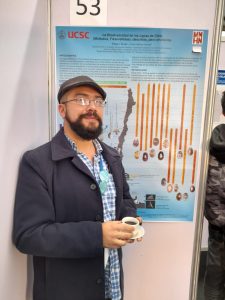Jean Pierre Molina.- This is a taxonomic and descriptive review of the species Fissurellidae (Mollusca, gastropod), from the coasts of Chile and which makes important contributions to research.
Felipe Torres, a second-year student of the Doctorate in Sciences with a mention in Biodiversity and Bioresources, (DCBB) postgraduate program carried out at the Faculty of Sciences of the Catholic University of the Santísima Concepción (UCSC), developed this research while completing his undergraduate studies. Master in Marine Biology at the Andrés Bello University, Santiago campus.
A marine biologist by profession, he came to the DCBB with a clear objective: to advance from descriptive science to science linked to current world problems. Thanks to his first years in the Ph.D. at UCSC, Felipe was able to advance in this research work, which although it began a few years ago, recently achieved its final publication. “This Doctorate strives to give practical use to science for a social or industrial purpose. This is very important in the current period of the world, to help the real problems. We need science not to remain only in scientific articles or in the academy, but to solve people’s real problems”, explained Felipe Torres, very much in tune with the line of Biodiversity and Bioresources, the focus of this postgraduate program.
Highlight the importance of the species
This is a work carried out under the aegis of the National Museum of Natural History of Chile, where he had access to first-source information. Although there was information on the species studied, it was not as well known. That was the main motivation of the young scientist to highlight the importance of Fissurellidae (Mollusca, gastropod). “There was a biological diversity that was already described in the literature, however, it was in little-known old publications, some in French or old German from 1800 that were never cited in later works. This work arose as an effort to collect the information we have from this group to show the biological diversity that was forgotten at some point”Torres comments.
Regarding the importance of research, Felipe Torres stresses that in order to understand the processes and evolution of this and other species, it is vital to find out about their origin, past and history. In this context, a new species was identified, which was a considerable contribution of the work carried out, located on Robinson Crusoe Island. In addition, it is noteworthy that They considered descriptions of all of Chile: insular, continental and Antarctic. The study lasted about four years and began when Felipe Torres was completing his Master’s degree in Marine Biology at the Universidad Andrés Bello.
“I had access to the collection of the National Museum of Natural History, which has hundreds of years of information. Samples that were collected by Rodulfo Philippi, the first director of this same museum, for example. It was wonderful for me to see the same specimens that were drawn more than a hundred years ago in the original descriptions and now hold them in my hands,” he added.
A challenge from every point of view, both professional and personal, is what the main author of this study is currently experiencing. To this end, the DCBB managed to cover new topics that today complement it to become the scientist it wants to become in the future.
“I needed to get out of my comfort zone, I was very comfortable in Santiago. I was living with my family, studying with the same professors who guided me through undergraduate. This graduate program was recommended to me by a UCSC Marine Biology graduate, Dr. Cristián Ibáñez, who was my professor. Then, I complemented the information that appeared on the web and social networks”, added Felipe Torres.
Regarding the importance of the study, Felipe Torres seeks relieve the seat that corresponds to the species. “The limpets are relatively common animals on the coasts of Chile and since ancient times they have accompanied the communities in different formats. There are records that show that these animals were removed to survive, for food and even for technology of the time such as jewelry, hooks or even arrows. My work comes to show part of the wealth that the coasts of the country have, ”he concluded.















